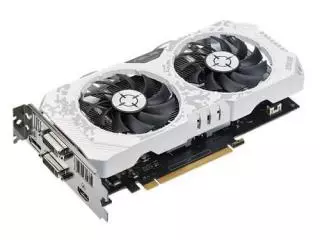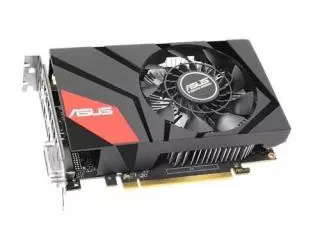GeForce GTX 950 vs Radeon R7 360
If you are going to buy a new graphics card and are choosing between GeForce GTX 950 and Radeon R7 360, there are a couple of things to consider. Cards with more VRAM in general perform better and allow you to play on higher graphics settings. Size also makes a difference. A model with a large heatsink can occupy up to three expansion slots on a motherboard. Be sure you have enough room in your PC case. When comparing GPUs with different architectures, more processing cores and even higher TFLOPS will not always translate to better performance. To help you decide which GPU you need, we have measured frame rates in a number of popular games. For more on how the GeForce GTX 950 stacks up against Radeon R7 360, check out specs charts below.
Main Specs
GeForce GTX 950
Radeon R7 360
Power consumption (TDP)
90 Watt
100 Watt
Interface
PCIe 3.0 x16
PCIe 3.0 x16
Supplementary power connectors
1x 6-pins
1 x 6-pin
Memory type
GDDR5
GDDR5
Maximum RAM amount
2 GB
2 GB
Display Connectors
1x DVI, 1x HDMI, 3x DisplayPort
1x DVI, 1x HDMI, 1x DisplayPort
Recommended system power (PSU)
350 Watt
Check Price
Check Price
Radeon R7 360 has 11% more power consumption, than GeForce GTX 950.
Both video cards are using PCIe 3.0 x16 interface connection to a motherboard.
GeForce GTX 950 and Radeon R7 360 have maximum RAM of 2 GB.
Both cards are used in Desktops.
GeForce GTX 950 is build with Maxwell architecture, and Radeon R7 360 - with GCN 2.0.
GeForce GTX 950 and Radeon R7 360 are manufactured by 28 nm process technology.
Radeon R7 360 is 158 mm longer, than GeForce GTX 950.
Memory clock speed of Radeon R7 360 is 5994 MHz higher, than GeForce GTX 950.
Game benchmarks
Assassin's Creed Odyssey
Battlefield 5
Call of Duty: Warzone
Counter-Strike: Global Offensive
Cyberpunk 2077
Dota 2
Far Cry 5
Fortnite
Forza Horizon 4
Grand Theft Auto V
Metro Exodus
Minecraft
PLAYERUNKNOWN'S BATTLEGROUNDS
Red Dead Redemption 2
The Witcher 3: Wild Hunt
World of Tanks
high / 1080p
35−40
16−18
ultra / 1080p
21−24
9−10
QHD / 1440p
16−18
4−5
4K / 2160p
10−11
4−5
low / 720p
60−65
30−35
medium / 1080p
40−45
20−22
The average gaming FPS of GeForce GTX 950 in Assassin's Creed Odyssey is 128% more, than Radeon R7 360.
high / 1080p
55−60
24−27
ultra / 1080p
45−50
21−24
QHD / 1440p
35−40
8−9
4K / 2160p
18−20
6−7
low / 720p
100−110
50−55
medium / 1080p
60−65
27−30
The average gaming FPS of GeForce GTX 950 in Battlefield 5 is 125% more, than Radeon R7 360.
low / 768p
50−55
45−50
QHD / 1440p
0−1
0−1
The average gaming FPS of GeForce GTX 950 in Call of Duty: Warzone is 10% more, than Radeon R7 360.
low / 768p
250−260
210−220
medium / 768p
220−230
180−190
ultra / 1080p
180−190
100−110
QHD / 1440p
110−120
55−60
4K / 2160p
70−75
30−35
high / 768p
210−220
140−150
The average gaming FPS of GeForce GTX 950 in Counter-Strike: Global Offensive is 43% more, than Radeon R7 360.
low / 768p
60−65
55−60
ultra / 1080p
−
40−45
medium / 1080p
55−60
45−50
The average gaming FPS of GeForce GTX 950 in Cyberpunk 2077 is 15% more, than Radeon R7 360.
low / 768p
120−130
110−120
medium / 768p
110−120
95−100
ultra / 1080p
100−110
65−70
The average gaming FPS of GeForce GTX 950 in Dota 2 is 23% more, than Radeon R7 360.
high / 1080p
45−50
18−20
ultra / 1080p
40−45
16−18
QHD / 1440p
27−30
16−18
4K / 2160p
14−16
6−7
low / 720p
80−85
40−45
medium / 1080p
45−50
20−22
The average gaming FPS of GeForce GTX 950 in Far Cry 5 is 115% more, than Radeon R7 360.
high / 1080p
60−65
24−27
ultra / 1080p
45−50
20−22
QHD / 1440p
27−30
16−18
4K / 2160p
27−30
−
low / 720p
180−190
100−110
medium / 1080p
110−120
55−60
The average gaming FPS of GeForce GTX 950 in Fortnite is 93% more, than Radeon R7 360.
high / 1080p
60−65
27−30
ultra / 1080p
45−50
21−24
QHD / 1440p
30−35
10−11
4K / 2160p
24−27
10−11
low / 720p
100−110
55−60
medium / 1080p
65−70
30−33
The average gaming FPS of GeForce GTX 950 in Forza Horizon 4 is 115% more, than Radeon R7 360.
low / 768p
140−150
85−90
medium / 768p
120−130
75−80
high / 1080p
70−75
30−35
ultra / 1080p
30−35
12−14
QHD / 1440p
21−24
3−4
The average gaming FPS of GeForce GTX 950 in Grand Theft Auto V is 88% more, than Radeon R7 360.
high / 1080p
24−27
10−11
ultra / 1080p
20−22
8−9
QHD / 1440p
16−18
−
4K / 2160p
8−9
3−4
low / 720p
65−70
30−35
medium / 1080p
30−35
12−14
The average gaming FPS of GeForce GTX 950 in Metro Exodus is 138% more, than Radeon R7 360.
low / 768p
130−140
110−120
medium / 1080p
120−130
100−110
The average gaming FPS of GeForce GTX 950 in Minecraft is 18% more, than Radeon R7 360.
high / 1080p
−
21−24
ultra / 1080p
14−16
18−20
low / 720p
100−110
55−60
medium / 1080p
18−20
24−27
The average gaming FPS of GeForce GTX 950 in PLAYERUNKNOWN'S BATTLEGROUNDS is 35% more, than Radeon R7 360.
high / 1080p
24−27
14−16
ultra / 1080p
16−18
10−11
QHD / 1440p
10−11
0−1
4K / 2160p
7−8
−
low / 720p
65−70
30−33
medium / 1080p
35−40
16−18
The average gaming FPS of GeForce GTX 950 in Red Dead Redemption 2 is 100% more, than Radeon R7 360.
low / 768p
130−140
55−60
medium / 768p
85−90
35−40
high / 1080p
45−50
20−22
ultra / 1080p
24−27
10−12
4K / 2160p
16−18
8−9
The average gaming FPS of GeForce GTX 950 in The Witcher 3: Wild Hunt is 129% more, than Radeon R7 360.
low / 768p
90−95
100−110
medium / 768p
60−65
60−65
ultra / 1080p
50−55
35−40
high / 768p
60−65
55−60
The average gaming FPS of GeForce GTX 950 in World of Tanks is 3% more, than Radeon R7 360.
Full Specs
GeForce GTX 950
Radeon R7 360
Architecture
Maxwell
GCN 2.0
Code name
GM206
Tobago
Type
Desktop
Desktop
Release date
20 August 2015
18 June 2015
Pipelines
768
768
Core clock speed
1024 MHz
Boost Clock
1188 MHz
1000 MHz
Transistor count
2,940 million
2,080 million
Manufacturing process technology
28 nm
28 nm
Texture fill rate
49.2 billion/sec
50.40
Floating-point performance
1,825 gflops
1,613 gflops
Length
7.938" (20.2 cm)
165 mm
Memory bus width
128 Bit
128 Bit
Memory clock speed
6.6 GB/s
6000 MHz
Memory bandwidth
105.6 GB/s
112 GB/s
Shared memory
-
G-SYNC support
+
DirectX
12 (12_1)
Shader Model
6.4
6.3
OpenGL
4.5
4.6
OpenCL
1.2
2.0
Vulkan
1.1.126
+
CUDA
+
Monero / XMR (CryptoNight)
0.2 kh/s
FreeSync
+
CUDA cores
768
Bus support
PCI Express 3.0
PCIe 3.0
Height
4.376" (11.1 cm)
SLI options
+
Multi monitor support
4 displays
HDMI
+
HDCP
+
Maximum VGA resolution
2048x1536
Audio input for HDMI
Internal
Bitcoin / BTC (SHA256)
233 Mh/s
225 Mh/s
Eyefinity
+
PowerTune
+
TrueAudio
+
Mantle
+
Design
reference
Bridgeless CrossFire
+
Number of Eyefinity displays
6
DisplayPort support
+
CrossFire
+
VCE
+
DDMA audio
+
Decred / DCR (Decred)
0.29 Gh/s
Ethereum / ETH (DaggerHashimoto)
9.97 Mh/s
10 Mh/s
Zcash / ZEC (Equihash)
102 Sol/s
GameStream
+
GeForce ShadowPlay
+
GPU Boost
2.0
GameWorks
+
Check Price
Check Price

